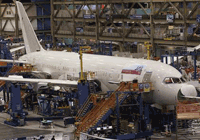
JAL sees 787 delivery delay, Boeing glitch
Tokyo, February 7, 2012
Flag carrier Japan Airlines said on Tuesday it no longer expects its first Dreamliner from Boeing Company by the end of February as a fresh manufacturing glitch is seen adding pressure to an already-tight 787 production timetable.
The Japanese carrier known as JAL, which has ordered 35 of Boeing's advanced carbon composite aircraft, said it is now in talks with the aircraft builder for possible delivery in March.
"Negotiations are still ongoing" with Boeing, JAL spokeswoman Sze Hunn Yap said. JAL had expected four 787s by the end of March, but "with this development we are unsure."
The world's second-largest commercial plane-maker insists it can fix what it described as "incorrect shimming" in support structures in the aft fuselage of some planes and meet its goal to make 10 Dreamliners per month by the end of next year.
Shims are used to close tiny gaps in joints along the fuselage.
Some analysts, however, say the target was unrealistic to begin with and a new glitch will slow production more.
"We don't know if this will impact production," EarlyBirdCapital managing director Alex Hamilton said.
"But if you have to go back and correct something and possibly change production going forward, it seems to have a good chance, in our opinion."
Hamilton, whose company does not own Boeing shares, is among many experts who doubted Boeing's ability to hit its 787 production target.
The company makes 2.5 Dreamliners per month. It expects to boost monthly output to 3.5 in the second quarter, and five by the end of 2012.
Much of that output is destined for Japan, where Boeing dominates its European rival Airbus with around a 90 percent market share.
In addition to the 35 jetliners destined for JAL, rival All Nippon Airways has ordered 55 787s and expects a further 20 to join its fleet by the end of March next year. The five aircraft now in service by ANA are operating as normal, a spokesman said.
ANA also said it was in talks with Boeing regarding future deliveries following the fuselage problem.
"We don't see any big impact, but it might push things back two or three months," spokesman Ryosei Nomura said.
Boeing's Dreamliner is the world's first commercial airplane made largely of lightweight carbon composites and entered service last year with ANA.
Boeing has taken 870 orders for the plane, which boasts greater fuel efficiency over rivals, but has been plagued by development and production delays, including a shortage of nuts and bolts in 2007, a 58-day labor strike in 2008 and a fire on a 787 test flight in 2010.
For JAL, which entered bankruptcy in January 2010 and is slated to emerge with a new stock exchange listing this year after a government-led bailout, a further wait for new jets will stall plans for use on high turnover routes including New Delhi, Moscow and Beijing in March, followed by Singapore and Boston later in the year.
Boeing said it is working to fix the problem.
"We have the issue well-defined and are making progress on the repair plan," Boeing spokesman Scott Lefeber said on Sunday.
"There is no short-term safety concern. Repairs, should they be needed, will be implemented in the most efficient manner possible."
Lefeber declined on Monday to comment on how many airplanes are being inspected, saying only that Boeing was working its way through the production line. A report from Flightglobal said three airplanes were affected.
Lefeber said that, in some instances, Boeing had discovered signs of "delamination," which occurs when repeated stress causes laminated composite materials to begin to separate.
The problem occurred in a part of the 787 fuselage made at a Boeing plant in South Carolina. Boeing purchased the plant in 2009 from Vought Aircraft Industries.
"We've already taken appropriate steps to address this issue there," Lefeber said, referring to the South Carolina factory.
But one expert said the problem also raises questions about manufacturing practices at the South Carolina plant.
"This is strictly a production problem," said Hans Weber, president of Tecop International, a technology management consultancy. "This is not a design problem. This is not even a production process problem. This is a problem of people improperly doing the assembly."
Other analysts however said Boeing is likely to overcome its latest glitch quickly.
Richard Aboulafia, an aerospace analyst at Virginia-based Teal Group, said problems related to the 787 are often magnified by the public because the plane incorporates new technology.
"There are people who are concerned about the use of composites. It's a minority view," Aboulafia said.
"Delamination, of course, goes to the very heart of the risk associated with this particular technology - composite materials in primary structures."
RBC Capital Markets analyst Rob Stallard said the shimming issue spoke to the integrity of the composites used in the 787, but he did not think it would disrupt the program.
"When you think of the big problems we've seen on the 787 over many, many years, this just looks like noise," Stallard said. "I'm sure these things happen in development programs all the time."
Airbus recently blamed a combination of manufacturing and design flaws for wing cracks on its A380 superjumbo. The company said it had found a simple remedy for the problem, easing concern among analysts. - Reuters







